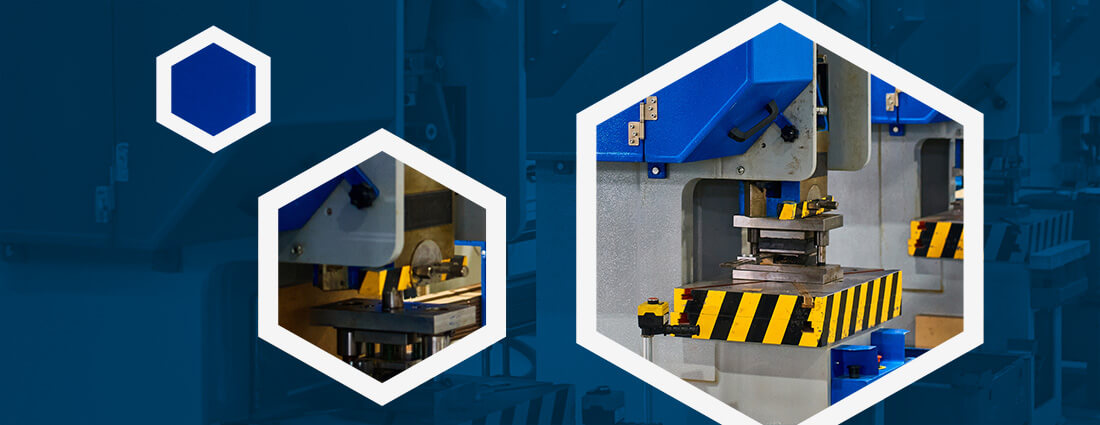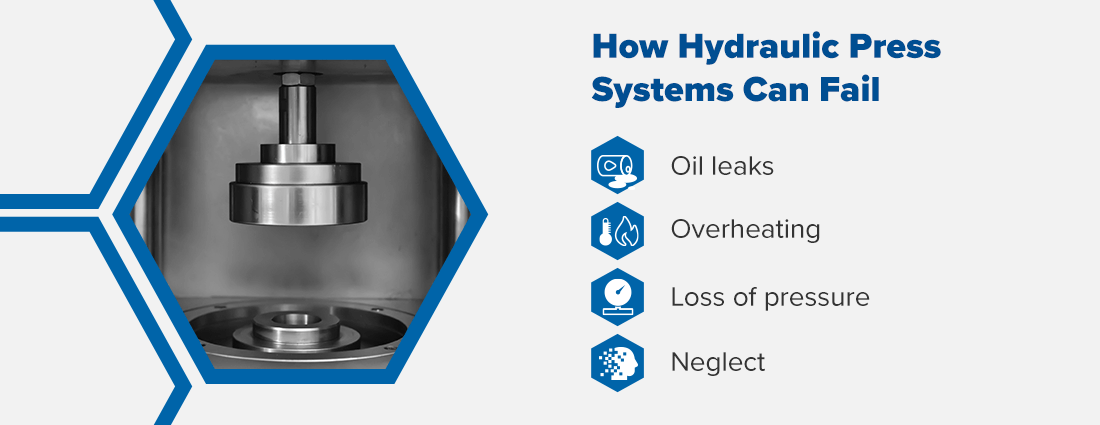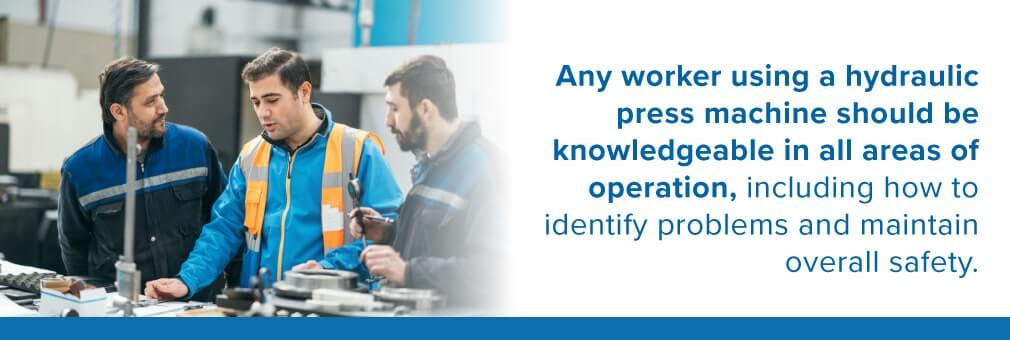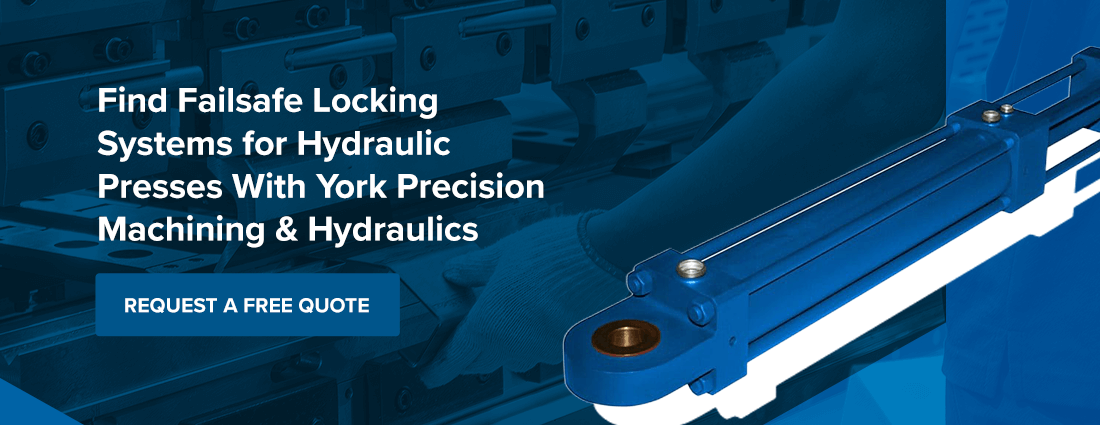Tips to Stay Safe When Operating a Hydraulic Press
Author: Michele Baker Ph.D
Table of Contents
- What Are Hydraulic Presses Used For?
- How Hydraulic Press Systems Can Fail
- Most Common Hydraulic Press Accidents in the Workplace
- The Best Hydraulic Press Precaution and Safety Tips
- Essential Hydraulic Press Safety Precautions
- How to Prevent Injury for Your Hydraulic Press Operators
- The Importance of Safety and Precautions With Hydraulic Presses
- Top Qualities to Look for in Hydraulic Press Locking Devices
- Find Failsafe Locking Systems for Hydraulic Presses
Hydraulic presses are important pieces of machinery in many different industries. With a broad variety of specialized and general uses, presses are a necessity for many manufacturers. But they also pose a high injury risk for operators. How can you be sure you are being as safe as possible around this heavy, potentially dangerous equipment?
As an owner or operator, you should already require workers to pay close attention to proper practices and equipment safeguards. However, machines are not guaranteed safe on their own. Human error and mechanical failures can occur. Without safety measures in place, your shop cannot work to its full potential. Using our hydraulic press safety tips can help you and your employees stay out of harm's way.
What Are Hydraulic Presses Used For and How Do They Work?
Hydraulic presses are large machines designed specifically to compress objects with a ram. They may also be used to cut or punch, drill, straighten and mold — any way you need to transform or manipulate large pieces of metal or strong material.
While presses are capable of a variety of functions, not many other machines can do what a press does — or, at least, not nearly as effectively or on such a large scale. Pneumatic and hydraulic presses work similarly but have a few large differences that set them apart.
Pneumatic actuators rely on air compression for their motion. Hydraulic actuators use compressed oils. The oils do not delay movement and offer a far higher pressure capability, making hydraulics more effective at tackling heavy-duty jobs.
There are several different types of hydraulic press systems, all with unique capabilities and uses. The most typical machines you will see in industrial settings include:
- H Frame presses: Also called a four-column, H frames are the most typical and versatile type of hydraulic press. They can be used with different dies for straightening, bending, forming, molding, punching or cutting metal objects.
- C Frame presses: These save a lot of space compared to the larger H frames but maintain similar functionality and versatility on a smaller scale.
- Arbor presses: Used for a slightly more narrow range, these are primarily for bearing removal, seating stamping, assembly and repairing equipment.
- Press brakes: Designed specifically for sheet metal and plate material, press brakes clamp material and bend it in predetermined areas. They are used for both large and small sheets.
- Custom presses: For specialized uses, businesses can order a custom press for their individual needs, designed to their specs.
Like any machine shop necessity, hydraulic presses make work more efficient and complete tasks that no other piece of equipment can carry out. However, presses can be highly dangerous machines due to their sheer power and number of moving parts.
How Hydraulic Press Systems Can Fail
Unfortunately, hydraulic presses are not foolproof. Over time and with heavy use, presses can become damaged or worn in crucial areas. They need regular maintenance and care if you expect top performance and years of functionality.
There are several common issues with hydraulic presses, potentially resulting in a broken machine or bodily injury. These include:
- Oil leaks: This is the most commonly reported problem. Oil can leak from hose fittings, hydraulic lines, and even around the ram. Leaking is typically the result of equipment damage, loose fittings, fluid contamination, and using the incorrect oil type. Continued leaking puts the machine at high risk for catastrophic failure and chemical hazard, endangering workers.
- Overheating: A wide array of machine inefficiencies can cause a press to overheat. Hydraulic fluid needs to remain under 180 degrees Fahrenheit in temperature. Any hotter than that, the oil can degrade quickly and cause seal damage, leading to leaks.
- Loss of pressure: This may sound like more of an inconvenience than anything, but improperly working equipment always has the potential for danger. Slow pressure build can be the result of a pump, relief valve, or motor issue. Pressure issues can cause the ram to drop unexpectedly and without being activated.
- Neglect: A machine is only as good as its weakest part. Without proper care and regular inspection, machines can fail for any number of reasons. Any issue left unrepaired or part left unreplaced can worsen with further use, creating a risk for full press failure.
Without correct care, presses can experience any of these failures and more. Daily inspection and regular maintenance can prevent them. Simple repair and safety measures cost far less than the potential damage that comes with leaving issues to worsen.
In many cases, full machine failure can cause your press to become permanently inoperable. More seriously, it can severely injure workers. Accidents caused by faulty machinery — especially a hydraulic press — can result in minor to fatal injury.
The Most Common Hydraulic Press Accidents in the Workplace
Hydraulic presses are tools, not toys. And like any tool, if improperly used, they can cause accidents — sometimes even if you think you are being safe.
Due to the nature of the hydraulic press and its functions, the most common workplace injuries involve hands and fingers. Pinching and crushing incidents are common. Using a press requires workers to place and shift metal near the bending point or in the area under the ram. These applications directly expose operators to a high-risk scenario. Approximately 49% of power press injuries result in amputation.
Press machines have so much room for failure if not cared for or operated properly, or if a preparation step is skipped. With a heavy ram under a high amount of pressure and no failsafe, the chance of catching a body part in the press may be higher than you would assume.
So, what are the hazards of a hydraulic press? Catastrophic failures can cause unexpected dangers like:
- Pressure failure can result in the ram dropping, crushing whatever sits under it at the time.
- Cracked or loose fittings can rupture, causing hoses to detach.
- Metal can fracture under pressure and fly in jagged pieces.
- Puncture wounds or lacerations from projectiles, pressurized hydraulic fluid and sharp metal can occur under severe conditions.
Press brakes, in particular, can be extremely dangerous — 83% of reported injuries happen where the press brake is not protected by safety measures. The press brakes' complicated configuration often requires operators to reach around the machine's safety device. When bending metal sheets with small surface areas, the operator must position their fingers within very close proximity to the point of bending. Even when the device is used properly, the risk of injury is high.
The Best Hydraulic Press Precaution and Safety Tips
As a business owner or machinist, you care about the safety of your hydraulic press operators. In order to lower the occupational risks for workers, you need to follow our hydraulic press safety rules and keep up with:
- Maintenance: One of the best ways of avoiding potential failure and injury is through preventive machine maintenance. Hydraulic presses are consistently under a lot of stress from high pressure, high temperatures and natural wear. Over time and with heavy use, parts and fluids require regular cleaning and replacement.
- Inspection: Give your machines a thorough inspection on a regular basis. You will want to check any hoses and seals for damage, fittings for cracks and a tight fit, fluids for dirt or degradation, and the general body of the machine for any cracks. Pay close attention to any excessive vibrations or strange noises when the machine is running, as they may indicate a need for urgent repair.
- Cleanliness: Keeping your hydraulics adequately lubricated and the surrounding area clean is essential not only for the machine to operate correctly but also for the safety of those using it. Lubrication ensures a smooth user experience by reducing friction and allowing a clean stroke. Alternatively, slick oil, clutter and dirt can create dangerous circumstances. Make sure there is no potential for slipping or catching clothing on discarded materials.
- Training: Any worker using a hydraulic press machine should be knowledgeable in all areas of operation to take proper safety precautions, including how to identify problems and maintain overall safety. Using a press is a specialized job, and knowing how to safely operate a hydraulic press takes experience and skill. Undertrained users have a much higher risk of injury than those who received proper training.
Essential Hydraulic Press Safety Precautions
One of the best ways to keep your workers safe is to mandate the use of safety equipment when operating the hydraulic press. Mandating bodies have created several regulations to promote safety and reduce risks by using proper equipment.
PPE Guidelines
The Occupational Safety and Health Administration (OSHA) outlines requirements for protective equipment for head, face, eyes and extremities. All operators must wear personal protective equipment (PPE) to prevent unnecessary hydraulic press injury. Items include:
- Eye protection: Operators must protect against flying debris, hydraulic fluid splashes and metal shards with safety glasses, face masks or face shields. Face shields are recommended when operators are working with materials that may produce fine particles or shatter.
- Hand protection: Gloves and arm coverings should be impact-resistant or cut-resistant. This equipment protects hands, arms and fingers from sharp edges, hot materials and pinch points.
- Foot protection: Operators must wear protective footwear to safeguard against crushing or heavy falling objects. Steel-toed boots and slip-resistant shoes protect the feet and prevent slips from oily surfaces or fluid leaks.
- Hearing protection: Earplugs or earmuffs must meet regulatory agency requirements for noise exposure. High-pressure operations can generate extreme noise, and prolonged exposure can cause hearing damage or loss.
- Body protection: Sturdy aprons, high-visibility vests and close-fitting clothing reduce the likelihood of bodily injury. Aprons and coveralls protect the body from fluid splashes or debris such as metal chips. High-visibility vests ensure others in the workspace can see the operator clearly. Operators should never wear loose-fitting clothing, as these articles can catch on equipment, potentially leading to increased injury risks.
- Head protection: Protective headgear is necessary in environments where overhead hazards threaten worker safety. Compliant headgear also protects from flying debris.
- Respiratory protection: Respiratory protection is not necessary for all hydraulic press applications. However, those working with materials that produce airborne particles, dust or fumes must have compliant respiratory protection.
Team members should also remove any jewelry to enhance safety during machine operation. Operators with long hair should secure it to prevent entanglement with moving parts.
Guards, Shields and Stopping Devices
OSHA defines general machine guarding requirements for all machines. The agency requires one or more methods of guarding to protect employees and operators from hazards associated with rotating parts, sparks, flying chips, ingoing nip points and point of operation. OSHA also requires additional specific safety measures for hydraulic presses. Requirements can vary by specific workplace and operation, but general examples include:
- Point-of-operation guards: OSHA mandates general guards like electronic safety devices, physical barriers and two-hand tripping devices. The agency also requires guards for foot pedals and enclosed pump and motor assemblies. The agency requires machine attachments where possible and the use of special hand tools to prevent hands from coming into close contact with the point of operation.
- Emergency stopping devices: Standards call for accessible stop buttons and power disconnection methods. OSHA rules also permit presence-sensing devices to automatically stop operation when a person or object disrupts the light beam transmitting between sensors. Emergency stop buttons must offer easy access to operators, and power transmission components should be enclosed and away from the operator.
All machine guards must maintain a secure attachment to the machine to ensure compliance. Additionally, the guards cannot interfere with the machine's operation.
York Precision Machining and Hydraulics helps you meet safety requirements with Bear-Loc®, an innovative positive locking device for hydraulic presses. Bear-Loc® automatically engages when hydraulic pressure unexpectedly drops, or when power is lost, to stop operation at any stroke point. Doing so locks in the load and prevents unintentional movement to increase your worksite safety.
How to Prevent Injury for Your Hydraulic Press Operators
Even when you use precautions, accidents can happen at any time. You need to be sure your workers stay safe under any circumstance, including machine failure and human error. For the best possible protection, make sure to follow our hydraulic press safety requirements listed above and outfit your machines with failsafe locking systems. Not all machines are required to have a failsafe system installed by the original manufacturer. While there are machine guarding standards, they do not guarantee safety. Locking actuators address this gap.
Hydraulic locking actuators and lock systems perform as secondary safety units, in addition to those that may be provided on a press machine. The highest-quality locking systems work by creating an interference fit with the outside diameter of the rod in order to lock it in place — similar to a clamp.
Upon applying hydraulic pressure, the sleeve expands, providing just enough clearance for the rod to complete its stroke. Note that many options on the market will not work in the case of pressure loss, rendering the locking system useless in an emergency need. Your actuator or system should be a guaranteed failsafe. For absolute assurance, it needs to include:
- Automatic locking: An automatic cylinder response, locking in the case of unexpected pressure release or power failure.
- Infinite-position locking: The ability to engage the lock at any point in the ram's stroke.
- Design simplicity: Added moving parts only add complications. Simple design allows for lower risk and less room for mechanical error.
The Importance of Safety and Precautions With Hydraulic Presses
Because hydraulic presses involve heavyweight, high-pressure and dangerous moving elements, hydraulic press safety standards are of the utmost importance. Machinists and press operators already face a risk of workplace accidents within close proximity of the ram stroke. Because they must hold metal objects near the area of impact, operators will suffer most from improper use or inadequate precautions.
Lack of safety precautions can also lead to a failure, causing the ram to drop suddenly. Depending on the use and timing, this can mean injury by way of crushing or a projectile. The ram can shatter objects completely, sending sharp pieces flying.
Even if a seal is deteriorating or a fitting is loose, it means potential loss of life for anyone near the machine. The numerous possibilities for accidents are enough to create serious concern and anxiety for operators. If they are not guaranteed safety, they will not be able to work efficiently or without high levels of stress.
Less severe but also important, failure and misuse damage the machine. The level of damage ranges from requiring repairs to rendering it useless, which means replacing the unit entirely.
While maintenance and acquiring safety devices for your hydraulic machines can be costly and time-consuming, it is a welcome trade-off for protecting your workers. With regular practices and fail-safe systems in place, your machinists can be efficient and happy knowing they are using a safe device.
Top Qualities to Look for in Hydraulic Press Locking Devices
Like the presses they fit on, not all locking devices are created equal. You want to purchase the best-fitting, most reliable device for your hydraulic press.
Custom building allows you to safeguard just about any of your hydraulic machines, even in restricted spaces and for specialized units. In order to request a custom build, you need to know a number of specifics:
- Quantity: How many locks do you require?
- Cylinder information: What are the sizes of the machine's bore and rod? What is the mounting style?
- Unlock pressure: Is your machine's unlock pressure 2000, 3000 or 5000 psi?
- Lock: What is the length of your machine's lock?
- Capacity: What is your machine's required locking capacity?
- Stroke length: How far does the piston of your hydraulic machine travel in the cylinder?
- Cushioning: What type of cushioning does your machine have? Is it non-cushioned? Does it have a cushioned rod end, blind end or both?
With this information, you will be ready to find the right lock system and locking actuator. You need to feel confident you are looking out for your workers' safety. Accidents happen, but you can prepare for them.
Find Failsafe Locking Systems for Hydraulic Presses
Bear-Loc® by York Precision Machining and Hydraulics was created for hydraulics operators everywhere. Our system creates a safer, lower-risk environment for you and your workers. With Bear-Loc®, you do not have to choose the closest fitting option. We custom build tailor-fit devices for your machines.
Our responsive team makes the ordering process hassle-free, so you can benefit from a custom Bear-Loc® without any stress. We also offer cost-effective repairs and replacements, just in case you need them.
There is no other hydraulic locking device with all of these features on the market. The complex and proprietary design is privately owned and cannot be reproduced by any other company. Bear-Loc® hydraulic cylinder lockout devices are one-of-a-kind, providing the safest and most reliable option for your business.
Our locking devices will benefit your business for decades of use. Choose to make your systems fail-safe with a Bear-Loc® hydraulic actuator or independent locking device. Contact us through our online form to request more information or get started with a no-obligation quote.
Awards & Certifications

ITAR Registered #M39417

Outstanding Performance

Excellence Presented By Commander

SIBC Member

ACIBC Member

NFPA Member

Made In USA
Last Updated: December 15th, 2019






